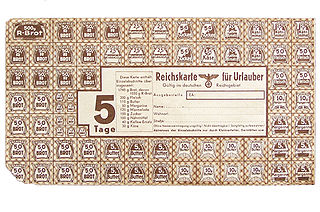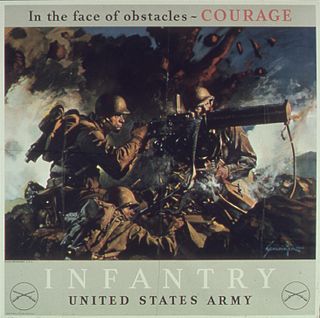
The Meal, Ready-to-Eat (MRE) is a self-contained individual United States military ration used by the United States Armed Forces and Department of Defense (DoD). It is intended for use by American service members in combat or field conditions where other food is not available. MREs have also been distributed to civilians as humanitarian daily rations during natural disasters.

The C-ration was a United States military ration consisting of prepared, canned wet foods. They were intended to be served when fresh or packaged unprepared food was unavailable, and survival rations were insufficient. It was replaced by the similar Meal, Combat, Individual (MCI) in 1958; its modern successor is the Meal, Ready-to-Eat (MRE).

Rationing is the controlled distribution of scarce resources, goods, services, or an artificial restriction of demand. Rationing controls the size of the ration, which is one's allowed portion of the resources being distributed on a particular day or at a particular time. There are many forms of rationing, although rationing by price is most prevalent.

Victory gardens, also called war gardens or food gardens for defense, were vegetable, fruit, and herb gardens planted at private residences and public parks in the United States, United Kingdom, Canada, Australia and Germany during World War I and World War II. In wartime, governments encouraged people to plant victory gardens not only to supplement their rations but also to boost morale. They were used along with rationing stamps and cards to reduce pressure on the food supply. Besides indirectly aiding the war effort, these gardens were also considered a civil "morale booster" in that gardeners could feel empowered by their contribution of labor and rewarded by the produce grown. This made victory gardens a part of daily life on the home front.

United States military ration refers to the military rations provided to sustain United States Armed Forces service members, including field rations and garrison rations, and the military nutrition research conducted in relation to military food. U.S. military rations are often made for quick distribution, preparation, and eating in the field and tend to have long storage times in adverse conditions due to being thickly packaged or shelf-stable.

The Minister of Food Control (1916–1921) and the Minister of Food (1939–1958) were British government ministerial posts separated from that of the Minister of Agriculture. In the Great War the Ministry sponsored a network of canteens known as National Kitchens. In the Second World War a major task of the Ministry was to oversee rationing in the United Kingdom arising out of World War II. The Minister was assisted by a Parliamentary Secretary. The Parliamentary Under Secretary of State for Food and Animal Welfare (2018–present) was appointed at the Department for the Environment, Food and Rural Affairs to ensure the continued supply of sufficient food during the Brexit process.

Rationing was introduced temporarily by the British government several times during the 20th century, during and immediately after a war.

The K-ration was a United States military ration consisting of three separately boxed meal units: breakfast, dinner, and supper. It was originally intended as an individually packaged daily ration for issue to airborne troops, tank crews, motorcycle couriers, and other mobile forces for short durations.

The term "home front" covers the activities of the civilians in a nation at war. World War II was a total war; homeland military production became even more invaluable to both the Allied and Axis powers. Life on the home front during World War II was a significant part of the war effort for all participants and had a major impact on the outcome of the war. Governments became involved with new issues such as rationing, manpower allocation, home defense, evacuation in the face of air raids, and response to occupation by an enemy power. The morale and psychology of the people responded to leadership and propaganda. Typically women were mobilized to an unprecedented degree.

A field ration or combat ration is a type of prepackaged military ration designed to be easily and quickly prepared and consumed in the field, in combat, at the front line, or where eating facilities are otherwise unavailable. Field rations are primarily used by military forces, though they are also sometimes distributed to civilians as part of humanitarian aid and emergency management. They differ from garrison rations and field kitchen provisions, which are intended for where proper meals can be supplied and prepared with relative ease and safety, such as in the rear where logistics are steady and fresh food can be supplied. They are similar to, but still mostly distinct from, camping food, emergency rations, and humanitarian daily rations.

Military chocolate has been a part of standard United States military rations since the original D-ration bar of 1937. Today, military chocolate is issued to troops as part of basic field rations and sundry packs. Chocolate rations served two purposes: as a morale boost, and as a high-energy, pocket-sized emergency ration. Military chocolate rations are often made in special lots to military specifications for weight, size, and endurance. The majority of chocolate issued to military personnel is produced by the Hershey Company.

A garrison ration is a type of military ration. Usually distinct from field rations, the term has varying meanings, but generally refers to either rations issued to personnel at a camp, installation, or other garrison; allowance allotted to personnel to purchase goods or rations sold in a garrison ; or a type of issued ration.

A ration stamp, ration coupon, or ration card is a stamp or card issued by a government to allow the holder to obtain food or other commodities that are in short supply during wartime or in other emergency situations when rationing is in force. Ration stamps were widely used during World War II by both sides after hostilities caused interruption to the normal supply of goods. They were also used after the end of the war while the economies of the belligerents gradually returned to normal. Ration stamps were also used to help maintain the amount of food one could hold at a time. This was so that one person would not have more food than another.

Foods of the American Civil War were the provisions during the American Civil War with which both the Union and Confederate armies struggled to keep their soldiers provisioned adequately.

During American involvement in World War II (1941–45), propaganda was used to increase support for the war and commitment to an Allied victory. Using a vast array of media, propagandists instigated hatred for the enemy and support for America's allies, urged greater public effort for war production and victory gardens, persuaded people to save some of their material so that more material could be used for the war effort, and sold war bonds.

Elsie Widdowson, was a British dietitian and nutritionist. She and Dr Robert McCance, a pediatrician, physiologist, biochemist, and nutritionist, were responsible for overseeing the government-mandated addition of vitamins to food and wartime rationing in Britain during World War II.

Military rations, operational rations, or military provisions are goods issued to sustain the needs of military personnel. As their name suggests, military rations have historically been, and often still are, subject to rationing, with each individual receiving specific amounts from available supplies. Military-issued goods and the rationing of such goods has existed since the beginnings of organized warfare.

The history of military nutrition in the United States can be roughly divided into seven historical eras, from the founding of the country to the present day, based on advances in food research technology and methodologies for the improvement of the overall health and nutritional status of U.S. military service members. Through the research and guidance of medical and military professionals, rations and packaging have been consistently and dramatically improved.
Food and Magic is a 1943 short documentary film commissioned by the United States Government during World War II. Food and Magic, was produced by the War Activities Committee of The Motion Picture Industry and it deals with food conservation and healthy eating. It stars Jack Carson as a sideshow barker who informs the crowd about proper wartime food consumption, including conservation and rationing.
Outpost is an animated short film, directed by Chuck Jones and first released in August, 1944. It is part of the Private Snafu series. As in all the Snafu films, the voice of Private Snafu is performed by Mel Blanc.

















